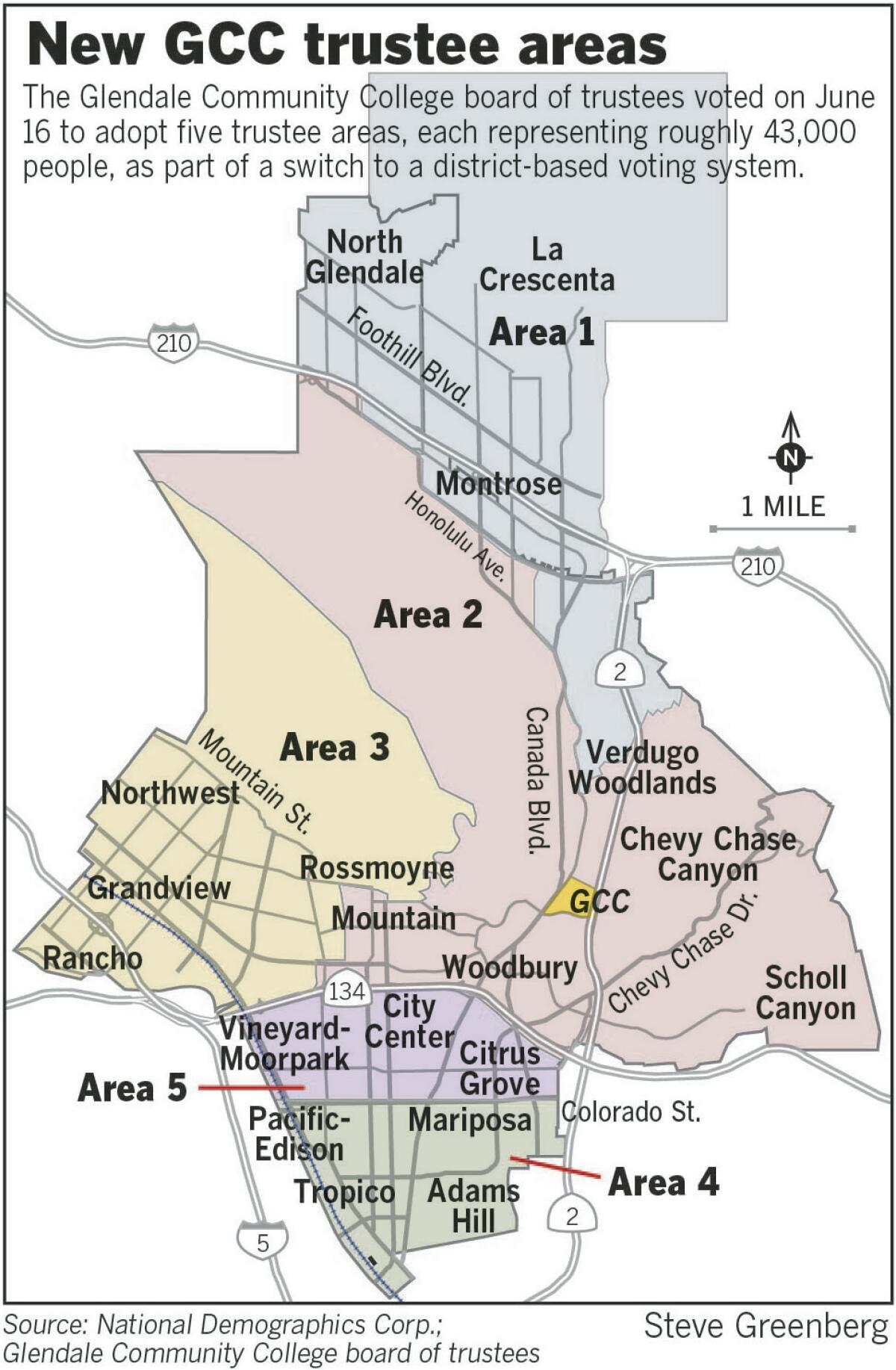Glendale Community College board settles on map with five voting districts

In about two years, trustees for the Glendale Community College board will be elected from five separate district. Trustees are currently elected on an at-large basis.
- Share via
Beginning in April 2017, the trustees of the Glendale Community College board are expected to be elected from five separate districts within Glendale, according to a plan the board agreed to adopt earlier this month.
College officials began looking to adopt a district-based voting system last year in response to the threat of a lawsuit under the California Voting Rights Act, which aims to protect the voting clout of minority groups in elections.
The law mandates a district-based system in elections where an at-large method would dilute minority groups’ votes.
The threat of a lawsuit became a reality when, in December 2014, Kevin Shenkman with the law firm Shenkman & Hughes notified the college, the Glendale Unified School District and the city of his intent to sue all three bodies for not having a district-based system.
But even as the college trustees spent the last several months taking several necessary steps to forgo their current at-large voting method, they have been outspoken in their opposition in switching to the district-based voting system.
That sentiment surfaced again on June 16 with the board’s final vote in adopting the five districts, which does not require Glendale voters’ approval, but it does need the OK of the state community college’s board of governors. It is expected to go before the board in the next few months, and is seen largely as a formality.
“I’ve been very vocal that Glendale was not the city the [California Voting Rights Act] was written for,” trustee Vahe Peroomian said. “We don’t know what’s going to happen as a result of this vote tonight… I’m casting my vote, but not willingly and not happily.”
The board is currently represented by two Anglos, two Armenian Americans and one Latina.
Trustee Anita Quiñonez Gabrielian said the new voting system represents an unintended consequence of “good, well-meaning law.”
Fellow trustees agreed, including Ann Ransford, who said, “I think we all feel that way.”
Still, the resolution to adopt the new district-based system, incorporating five districts with roughly 43,000 people living in each one, won a unanimous vote from the board.
Douglas Johnson of National Demographics Corp. worked with college officials to draft plans for various districts. He said the selected plan “made the most sense” for the board as they worked to follow all the necessary criteria in establishing districts, with the major requirement that each area would need to contain the same number of residents.
Shenkman’s 2014 threat also spurred Glendale officials to ask voters during this past April election whether the city should move toward a district-based voting system. That measure was struck down, along with a separate measure on the ballot that asked residents if the Glendale Unified School District should conduct its own election, which would have paved the way for the district to adopt a district-based voting system before April 2017.
Ten days after the two measures were struck down, Shenkman sued Glendale Unified. While he has not sued the city, Glendale officials have said there could be litigation in the future and a change to the voting system may have to be made.
Should the school district and the city adopt district-based methods, Johnson said their maps would not necessarily resemble the college’s plan.
“The city’s districts will have to look significantly different,” he said, in part because the city has different borders than the college district.
The college district also differs from Glendale Unified because the school district’s boundaries would need to consider school-attendance zones, he added.
The Glendale Unified and college districts are also made up of residents living in the unincorporated area of La Crescenta, which would not be factored into the city’s plan, should they adopt a district-based system.
Looking ahead, trustee Tony Tartaglia urged college officials to make a concerted effort to recruit residents to run in the two most southern districts, where no current incumbents reside.
“I hope we do a vigorous outreach in terms of getting people to run in those districts, and my expectation will be that this board will push heavily to spend necessary dollars… to inform our community,” Tartaglia said.
--
Kelly Corrigan, kelly.corrigan@latimes.com
Twitter: @kellymcorrigan
